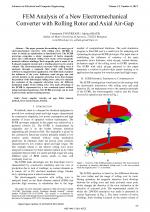| 4/2015 - 9 |
FEM Analysis of a New Electromechanical Converter with Rolling Rotor and Axial Air-GapUNGUREANU, C. |
| Extra paper information in |
| Click to see author's profile in |
| Download PDF |
Author keywords
angular velocity, air gap, finite element method, force measurement, friction
References keywords
design(8), motor(7), machines(6), rotor(5), rolling(5), axial(5), simion(4), flux(4), electromagnetic(4), analysis(4)
Blue keywords are present in both the references section and the paper title.
About this article
Date of Publication: 2015-11-30
Volume 15, Issue 4, Year 2015, On page(s): 69 - 74
ISSN: 1582-7445, e-ISSN: 1844-7600
Digital Object Identifier: 10.4316/AECE.2015.04009
Web of Science Accession Number: 000368499800009
SCOPUS ID: 84949948015
Abstract
The paper presents the modeling of a new type of electromechanical converter with rolling rotor (ECRR) in order to obtain an optimisation at functional level. The ECRR prototype comprises a stator composed of twelve magnetic poles and a disk-shaped rolling rotor made of ferromagnetic material, without windings. Each magnetic pole is made of an E-shaped magnetic system and a winding placed on its central column. The electromechanical converter with rolling rotor is analyzed through a magnetic field study with Flux2D software in magnetostatic application. The field study examines the influence of the rotor thickness, axial air-gap size and current density on the magnetic attraction force that changes the position of the disk-shaped rolling rotor. Also, it is analyzed the variation of the magnetic attraction force for different inclination angles of the rolling rotor. The main advantage of the ECRR is represented by a low rotational speed without using mechanical gearboxes. The ECRR prototype can be used in photovoltaic panels tracking systems. |
| References | | | Cited By |
Web of Science® Times Cited: 10 [View]
View record in Web of Science® [View]
View Related Records® [View]
Updated 1 week, 5 days ago
SCOPUS® Times Cited: 10
View record in SCOPUS® [Free preview]
View citations in SCOPUS® [Free preview]
[1] Comparison of the performance of bridge and bridgeless shaded pole induction motors using FEM, Dalcalı, Adem, Akbaba, Mehmet, International Journal of Applied Electromagnetics and Mechanics, ISSN 1383-5416, Issue 3, Volume 54, 2017.
Digital Object Identifier: 10.3233/JAE-160133 [CrossRef]
[2] Considerations regarding the practical implementation of the heliothermic actuator in the form of flat spiral spring, Romanescu, Adrian Neculai, Cernusca, Dumitru, Poienar, Mihaela, Milici, Dan Laurentiu, 2016 International Conference and Exposition on Electrical and Power Engineering (EPE), ISBN 978-1-5090-6129-7, 2016.
Digital Object Identifier: 10.1109/ICEPE.2016.7781324 [CrossRef]
[3] Theoretical and experimental contribution of using special actuators and materials with shape memory, Cernusca, Dumitru, Milici, Dan Laurentiu, Ungureanu, Constantin, 2016 International Conference and Exposition on Electrical and Power Engineering (EPE), ISBN 978-1-5090-6129-7, 2016.
Digital Object Identifier: 10.1109/ICEPE.2016.7781327 [CrossRef]
[4] CEUS figures finite element modelling, Tanta, Ovidiu Magdin, Daniela Olariu, Elena, Poienar, Mihaela, Milici, Dan Laurentiu, 2016 International Conference and Exposition on Electrical and Power Engineering (EPE), ISBN 978-1-5090-6129-7, 2016.
Digital Object Identifier: 10.1109/ICEPE.2016.7781326 [CrossRef]
[5] Modeling and FEA analysis of axial flux PMG for low speed wind turbine applications, Nataraj, Anitha, Ramasamy, Bharanikumar, 2017 International Conference on Technological Advancements in Power and Energy ( TAP Energy), ISBN 978-1-5386-4021-0, 2017.
Digital Object Identifier: 10.1109/TAPENERGY.2017.8397290 [CrossRef]
Disclaimer: All information displayed above was retrieved by using remote connections to respective databases. For the best user experience, we update all data by using background processes, and use caches in order to reduce the load on the servers we retrieve the information from. As we have no control on the availability of the database servers and sometimes the Internet connectivity may be affected, we do not guarantee the information is correct or complete. For the most accurate data, please always consult the database sites directly. Some external links require authentication or an institutional subscription.
Web of Science® is a registered trademark of Clarivate Analytics, Scopus® is a registered trademark of Elsevier B.V., other product names, company names, brand names, trademarks and logos are the property of their respective owners.
Faculty of Electrical Engineering and Computer Science
Stefan cel Mare University of Suceava, Romania
All rights reserved: Advances in Electrical and Computer Engineering is a registered trademark of the Stefan cel Mare University of Suceava. No part of this publication may be reproduced, stored in a retrieval system, photocopied, recorded or archived, without the written permission from the Editor. When authors submit their papers for publication, they agree that the copyright for their article be transferred to the Faculty of Electrical Engineering and Computer Science, Stefan cel Mare University of Suceava, Romania, if and only if the articles are accepted for publication. The copyright covers the exclusive rights to reproduce and distribute the article, including reprints and translations.
Permission for other use: The copyright owner's consent does not extend to copying for general distribution, for promotion, for creating new works, or for resale. Specific written permission must be obtained from the Editor for such copying. Direct linking to files hosted on this website is strictly prohibited.
Disclaimer: Whilst every effort is made by the publishers and editorial board to see that no inaccurate or misleading data, opinions or statements appear in this journal, they wish to make it clear that all information and opinions formulated in the articles, as well as linguistic accuracy, are the sole responsibility of the author.



